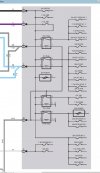Lol, here we are discussing about how to install it right... I don’t think this falls anywhere close to that category. Their solution may result in a completely unprotected circuit if they aren’t careful, not to mention a bunch of other possible hazards.
It’s been so long that I’ve looked at this thread I have forgotten where we left off. I know I said I would get back with examples but i never have had the time to do that. Forgive me if I repeat myself...
I think the most accurate answer is, it depends. It depends on your supply wire size and how the car was wired. I’ve found some circuits are powered from a main feeder while others are not. It depends on the make and model and year. For the best suited solution for your vehicle it is going to require some research, because I know some of you on here are into more than dash cams, this info will probably get applied to audio equipment, lights, Radios, and other accessories.
The safest solution if you don’t want to research the wiring setup in your vehicle and you don’t want to risk overloading the circuit that you are tapping into then the solution for you would be to run the second fuse in series with the circuit you are pulling power from. If the dash cam pulls so little current that you believe unloading the circuit is unlikely then running through the original fuse is probably also negligible. Never attach to a circuit that will cause a dangerous situation if the original fuse were to fail or cause the whole circuit to stop functioning.
research will need to be done before adding anything to the fuse in a parallel installation with the original fuse so that you are sure the wire feeding that fuse does not become overloaded. If it can handle the additional amperage then proceed with your install, if it can not then find a different circuit or run a new circuit. If installing in parallel then calculate the allowable load for your vehicles wire feeding the particular fuse that you are attaching to and make sure the total amperage of your fuses combined do not exceed the ampacity that your wire is rated for. Do not blindly install the supplied high amperage fuse without first confirming that it will maintain proper protection to your circuit in the event that it’s required, if it’s too large of an amperage then change it to one that is properly sized. Make sure that any relays on that wire will also be able to handle the total combined ampacity.
There is not a simple “this way is right, that way is wrong” answer because different vehicles are wired different from each other. What works in one vehicle make/model may not work at all in another. We can find examples all day for car wiring diagrams that support each method of install and they would all be correct for that method. We could also find examples of why each method is not the best or correct way to install, those would also be correct. It really depends on how the vehicle was constructed.
Remember, the fuse is not to protect your equipment from over amping under normal operation, your equipment should have protection built into it to protect from that already, it is there to protect the wires from catching on fire or melting in the event of a problem or accident. The last thing you want to have happen is for your car to catch fire following an accident because the wires on that circuit became damaged and allowed too much current to flow through the feeder wire before the circuit protection was able to preform its job (or pick any other potential cause of failure). That is only a possibility with a parallel install, but if sized correctly then it should still protect against that. I just witnessed an accident where the front end of a vehicle was mangled and the driver was unconscious for about three minutes. That would have been three minutes of smoke filling the vehicle. Three minutes where the person or their infant would not be able to escape the flames. This is just one of many very possible scenarios since accidents occur every day. Whatever method you find works for you please make sure you install it with safety as your number one concern for you and the future owners of the vehicle.
Sent from my iPhone using Tapatalk

